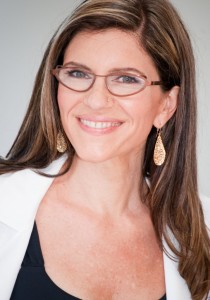I’m a Doctor. Here’s What I Eat On a Typical Day.
I’m a board-certified gynecologist who practices functional medicine for women but I’m also a regular gal – busy working mom, constant chauffeur for my daughters, devoted wife, and spiritual seeker. I help women balance their hormones naturally, starting with their fork. I know that good food needs to be easy and convenient, or it’s unlikely to happen. Making wise food choices used to be a daily challenge for me, but it gets easier with practice and viewing food preparation as a sadhana or spiritual practice.
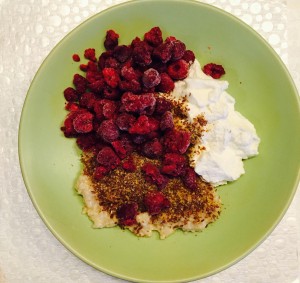 I believe anyone can change the way they eat, making adjustments that provide healing. Often your body sends you sacred messages that your food plan needs to change. Perhaps binges, breakouts, or bloating are plaguing you. I have a “food first” philosophy and passionately believe that food is the small hinge that swings the biggest doors when it comes to your health.
I believe anyone can change the way they eat, making adjustments that provide healing. Often your body sends you sacred messages that your food plan needs to change. Perhaps binges, breakouts, or bloating are plaguing you. I have a “food first” philosophy and passionately believe that food is the small hinge that swings the biggest doors when it comes to your health.
Here’s what a typical day looks like on my food plan. I like to keep my routine as regular as possible, so that there’s time for the love and grace to seep in. My day begins at 6 a.m. and ends at 10 p.m., and I pay attention natural rhythms like my circadian clock and Ayurvedic dosha tendencies (I’m pitta-kapha).
I start my day with a steamy mug of green tea. My current favorite is genmaicha, a combination of green tea and brown rice. I steep organic loose tea for 4 minutes and then add a fresh squeeze of Meyer lemon. Occasionally, I’ll whip up matcha tea, but most days that feels way too high maintenance. I encourage my patients to replace their coffee with tea to decrease the amount of caffeine they are drinking, which can make you feel stressed or disrupt your sleep if you metabolize caffeine slowly like I do (along with 51% of Americans).
Supplements
I interpret “what I eat” to include all the products that pass my lips, including supplements. While my tea is brewing, I drink a full glass of filtered water and take my supplements. Right now that includes the following:
- For thyroid support: 1 grain of WP Thyroid, which has no fillers. It contains natural dessicated thyroid in a combination of T3/T4 that suits my body. It also contains inulin from chicory root and medium chain triglycerides from coconut, an easily absorbed fat. (Available by prescription only.)
- For estrogen support (I’m low): maca and di-indole-methane.
- For antioxidant support: alpha lipoic acid
- Liver support: I take milk thistle and N-acetyl cysteine.
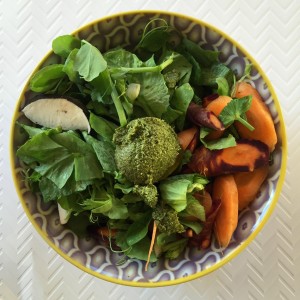 Eating for Hormone Balance
Eating for Hormone Balance
I gain weight way too easily (diabetes runs in my family as does poor stress resilience), so I’m strategic with my food plan. I eat foods that stabilize my blood sugar and don’t cause high cortisol if you’re intolerant like me – that includes amping up fiber and avoiding gluten. I choose foods and drinks that are high in nutrient density, with broad diversity of species so that my microbiome is happy. I have hypothyroidism, or a slow thyroid, so I try my best to avoid raw goitrogens like cruciferous vegetables and soy. I still eat broccoli, kale, collards, cauliflower, etc. but I lightly steam them to inactivate most of the goitrogens. I like tempeh, a fermented form of whole soy, but chose the types that are not combined with grains. You’ll find a lot of fermented vegetables on my meal plan because they are nature’s probiotic and help you reset your insulin so that you don’t store fat at your belly and raise your blood sugar unnecessarily. I eat low-mercury, wild-caught fish almost daily because it keeps my fatty acids in balance. I have a gene called PPARG that keeps my weight down if I eat more fish than meat, so you’ll find a lot of salmon, halibut, cod, and steelhead trout on the menu.
Most of all, I eat portions that are right for my body, because I’m a recovering food addict who gains weight if I eat unmeasured food. In the spirit of transparency, I’ve included the measurements of all of my food.
Quiet Time
While I sip my green tea, I sit by the fire and meditate for 30 minutes before my kids wake up. This time is non-negotiable. Sometimes I sit and connect to inner divinity. Sometimes I practice yin yoga. Sometimes I simply do bridge pose with all of my favorite variations. Sometimes I just nudge my breath to support my nervous system: inhale for a 4-count, hold for 7 counts, and exhaling for an 8-count. (If you’re too busy, just do 4-7-8 twice to reset your nervous system. Amazing!)
 Breakfast
Breakfast
That brings us to the first meal of the day, which is crucial for setting up the metabolic tone for the day. I eat around 7 a.m. with my family – my husband, David Gottfried, and two daughters. I take 3 deep breaths before I eat because my old habit was to skip breakfast or shovel it in while speed-reading The New York Times. Distracted eating raises cortisol, your main stress hormone.
Here’s the menu:
- 1 ounce of gluten-free steel-cut oats, which I bring to a boil with sea salt the night before and let steam overnight.
I place the cooked oats in a huge bowl (see photo). Then I add:
- 1 ounce freshly ground flax, organic cinnamon, and a little more sea salt (my blood pressure tends to be low, and I need sea salt to help support my adrenal glands!)
- 6 ounces blueberries or other fruit in season
Finally, I eat 2 pastured eggs, either poached or cooked over easy in coconut oil in my Scanpan. I love the Vital Eggs from whole foods, or duck eggs from my local community-sponsored kitchen. Occasionally, I’ll eat sheep or goat yogurt instead of the eggs, but you may want to consider avoiding dairy if you struggle with acne, autoimmunity, or food intolerances. (Nonstick pans with Teflon can disrupt your hormones. Perfluorooctanoic acid (PFOA), a synthetic chemical used to make teflon, is a possible carcinogen. Instead, use cast iron, enameled cast iron (like Le Crueset), or Scanpan, which is a PFOA-free nonstick product that I love.)
Every quarter, I run my online detox for 21-days and start my day with a shake. In the new online course that I’ve created with MindBodyGreen, you’ll learn my favorite shake recipes. Click here to learn more.
Beware of Restaurant Syndrome
I avoid eating at restaurants as much as possible because of “Restaurant Syndrome” – the phenomenon of overeating in response to the convivial atmosphere, drinking alcohol and less inhibition, the yummy sights and smells, and large serving sizes – all of which contribute to a documented increased risk of blood sugar problems and weight gain. In fact, in a study of 99,000 men and women followed over 30 years, people who average two homemade meals per day have a 13% lower chance of diabetes than people who have fewer than six homemade meals per week.1http://www.hsph.harvard.edu/news/hsph-in-the-news/homemade-meals-may-help-reduce-type-2-diabetes-risk/; You lose weight over time, because out-of-home eating is associated with becoming overweight and obesity.2http://www.ncbi.nlm.nih.gov/pubmed/24499144;
http://www.ncbi.nlm.nih.gov/pubmed/25963602 When you dine with friends and are distracted, you eat as much as 35 percent more.3 http://www.ncbi.nlm.nih.gov/pubmed/7826053; http://www.ncbi.nlm.nih.gov/pubmed/11470720; http://www.ncbi.nlm.nih.gov/pubmed/16757007 Yes, it sucks. The carbs and industrial seed oils, gluten, dairy, and additives make it tough on the body to reduce inflammation, and it can show up in your skin and bathroom scale. So when I’m on the road, I take my food with me in a cute glass container when I need to eat outside my home.
Work
I’m an author, speaker, and teacher. I work from home on my treadmill desk. I’ve just submitted my third book to my publisher and logged 2,500 miles while writing it. After I take my kids to school, I head home, lace up my running shoes, and walk while writing. My mind is clearest from about 8:30 a.m. to 12:30 p.m., and I need these large chunks of time to write my best. Occasionally, I’ll shoot video or teach online or travel, but mostly you’ll find me walking 2-3 miles per hour in my home gym before and after lunch, until it’s time to pick up the kids from school.
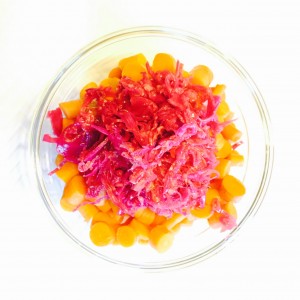 Lunch
Lunch
At 12:30 p.m., I assemble lunch. It’s the same framework each day: 4 ounces of protein, 6 ounces of cooked vegetables, and 6 ounces of a finger salad – all usually leftover from the day before. Here’s today’s menu:
- 4 ounces of Steelhead trout (similar to salmon)
- 6 ounces of mixed fermented vegetables (cabbage and turnips)
- Finger salad: 6 ounces of thick-sliced zucchini and carrots
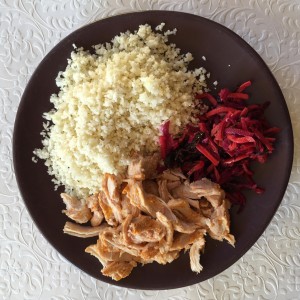 Dinner
Dinner
We eat a family dinner at about 6:30 p.m. each day. Here’s today’s selection:
- 4 ounces of pastured chicken
- 6 ounces cauliflower rice (a great swap for grain)
- 8 ounces salad with 2 tablespoons of dressing. Today’s salad has arugula, chopped pea greens, rainbow carrots, sliced hearts of palm, and shredded purple cabbage. Eating most of the colors of the rainbow each day helps to fill your micronutrient gaps.
Food is information for your DNA and cells. Food tells your body what to do. Eating for hormone balance is now second nature to me. I follow my food code – my personal code for eating congruent with my values and bodily needs, while honoring the fact that I’m a recovering addict who always wants more. It keeps me on the path of hormonal balance and helps me fit into my skinny jeans. If you don’t eat this way, consider trying my food plan for a few days and see how you feel.
If you want more ideas for your food plan, check out the online course I created with MindBodyGreen. You’ll learn the food rules that will allow you to eat mindfully – either at home or at a restaurant – and clear your skin, sleep well, and repair your digestion.
References
| ↑1 | http://www.hsph.harvard.edu/news/hsph-in-the-news/homemade-meals-may-help-reduce-type-2-diabetes-risk/; |
|---|---|
| ↑2 | http://www.ncbi.nlm.nih.gov/pubmed/24499144; http://www.ncbi.nlm.nih.gov/pubmed/25963602 |
| ↑3 | http://www.ncbi.nlm.nih.gov/pubmed/7826053; http://www.ncbi.nlm.nih.gov/pubmed/11470720; http://www.ncbi.nlm.nih.gov/pubmed/16757007 |

